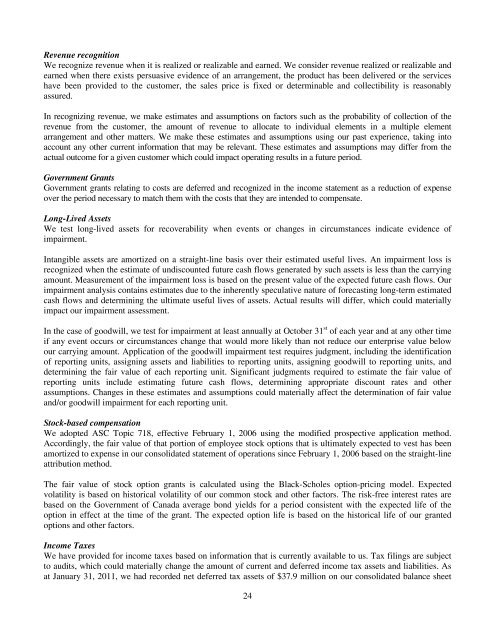THE DESCARTES SYSTEMS GROUP INC.
THE DESCARTES SYSTEMS GROUP INC.
THE DESCARTES SYSTEMS GROUP INC.
You also want an ePaper? Increase the reach of your titles
YUMPU automatically turns print PDFs into web optimized ePapers that Google loves.
Revenue recognition<br />
We recognize revenue when it is realized or realizable and earned. We consider revenue realized or realizable and<br />
earned when there exists persuasive evidence of an arrangement, the product has been delivered or the services<br />
have been provided to the customer, the sales price is fixed or determinable and collectibility is reasonably<br />
assured.<br />
In recognizing revenue, we make estimates and assumptions on factors such as the probability of collection of the<br />
revenue from the customer, the amount of revenue to allocate to individual elements in a multiple element<br />
arrangement and other matters. We make these estimates and assumptions using our past experience, taking into<br />
account any other current information that may be relevant. These estimates and assumptions may differ from the<br />
actual outcome for a given customer which could impact operating results in a future period.<br />
Government Grants<br />
Government grants relating to costs are deferred and recognized in the income statement as a reduction of expense<br />
over the period necessary to match them with the costs that they are intended to compensate.<br />
Long-Lived Assets<br />
We test long-lived assets for recoverability when events or changes in circumstances indicate evidence of<br />
impairment.<br />
Intangible assets are amortized on a straight-line basis over their estimated useful lives. An impairment loss is<br />
recognized when the estimate of undiscounted future cash flows generated by such assets is less than the carrying<br />
amount. Measurement of the impairment loss is based on the present value of the expected future cash flows. Our<br />
impairment analysis contains estimates due to the inherently speculative nature of forecasting long-term estimated<br />
cash flows and determining the ultimate useful lives of assets. Actual results will differ, which could materially<br />
impact our impairment assessment.<br />
In the case of goodwill, we test for impairment at least annually at October 31 st of each year and at any other time<br />
if any event occurs or circumstances change that would more likely than not reduce our enterprise value below<br />
our carrying amount. Application of the goodwill impairment test requires judgment, including the identification<br />
of reporting units, assigning assets and liabilities to reporting units, assigning goodwill to reporting units, and<br />
determining the fair value of each reporting unit. Significant judgments required to estimate the fair value of<br />
reporting units include estimating future cash flows, determining appropriate discount rates and other<br />
assumptions. Changes in these estimates and assumptions could materially affect the determination of fair value<br />
and/or goodwill impairment for each reporting unit.<br />
Stock-based compensation<br />
We adopted ASC Topic 718, effective February 1, 2006 using the modified prospective application method.<br />
Accordingly, the fair value of that portion of employee stock options that is ultimately expected to vest has been<br />
amortized to expense in our consolidated statement of operations since February 1, 2006 based on the straight-line<br />
attribution method.<br />
The fair value of stock option grants is calculated using the Black-Scholes option-pricing model. Expected<br />
volatility is based on historical volatility of our common stock and other factors. The risk-free interest rates are<br />
based on the Government of Canada average bond yields for a period consistent with the expected life of the<br />
option in effect at the time of the grant. The expected option life is based on the historical life of our granted<br />
options and other factors.<br />
Income Taxes<br />
We have provided for income taxes based on information that is currently available to us. Tax filings are subject<br />
to audits, which could materially change the amount of current and deferred income tax assets and liabilities. As<br />
at January 31, 2011, we had recorded net deferred tax assets of $37.9 million on our consolidated balance sheet<br />
24



